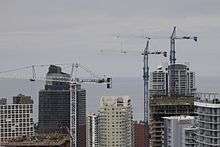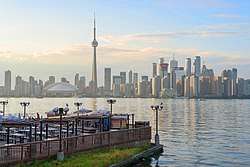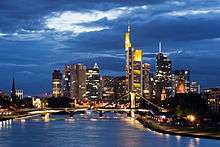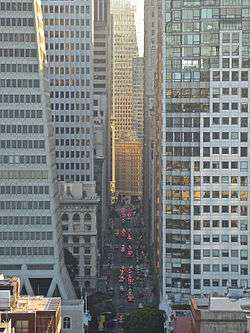Manhattanization
Manhattanization is a neologism coined to describe the construction of many tall or densely situated buildings, which transforms the appearance and character of a city to what is similar to Manhattan, the most densely populated borough of New York City.[1] It was a pejorative word used by critics of the highrise buildings built in San Francisco during the 1960s and 1970s, who claimed the skyscrapers would block views of the bay and the surrounding hills.[2] With careful urban planning, the phenomenon became more accepted in time.[3] The term also gained usage as a buzzword for high-density developments in Las Vegas, Nevada,[4][5] Los Angeles,[6] Dubai,[7] and Miami in the early 2000s[8] and again in the 2010s.[9] Another example is the high rise development in Toronto since 2007,[10] as well as rapid development of skyscapers in Hong Kong since the 1990s, eventually allowing the city to possess more skyscrapers than New York.[11][12] The term has even been applied to many smaller US cities that have seen a large spike in downtown high rise rental buildings since the 21st Century.[13] Nonetheless, these cities would have to multiply their populations many times over to match the population density of Manhattan, though this is a biased comparison between a city and a district, as even the other four "outer boroughs" of New York City would have to nearly triple in population to match Manhattan's current density.[14]

Miami

The term "Manhattanization" has been used to describe the 2003–2008 boom of real estate developments in Miami that brought the construction of more than 50 high rise buildings throughout the city.[15][16] A second housing market boom took place in Miami from 2012 to present (As of November 2015).[17] Along with the over ten thousand residential units added, the downtown area saw a revitalization and an increased prevalence of walking and public transport usage,[18][19] similar to Manhattan. Miami is sometimes likened to a "southern Manhattan" not only for its high rises, but for its large financial district.[20] Miami is now the US city with the third most skyscrapers (behind New York City and Chicago).
San Francisco
The term "Manhattanization" was initially used to describe the construction of large skyscrapers in San Francisco's Financial District in the 1970s. Since then, tall buildings have proliferated in San Francisco. This has expanded to the South of Market neighborhood. From 2000 to 2018, more than 15 buildings taller than 30 stories were built.[21] There are now over 160 buildings taller than 73 metres (240 ft). This is potentially worrisome as the area where most of the skyscrapers are located is on land with high potential for soil liquefaction.[22]
Sanhattan
.jpg)
"Sanhattan" has been used as a portmanteau to describe the developed cluster of skyscrapers in Santiago, Chile.[23][24]
Toronto

Downtown Toronto, has experienced a construction boom since 2007, primarily in its development of condominiums and other high rise residential towers. In one week of 2014, Toronto's city council approved 755 stories of new development in the city's downtown core.[25]
Gallery
.jpg) Panhattan, the skyline of Panama City, the capital of Panama
Panhattan, the skyline of Panama City, the capital of Panama.jpg)
 Skyline of Frankfurt, known as Mainhattan.
Skyline of Frankfurt, known as Mainhattan. Donau City Vienna, Austria
Donau City Vienna, Austria
See also
References
Footnotes
- "Definition of Manhattanize at Dictionary.com". Archived from the original on May 7, 2009. Retrieved June 28, 2015.
- "Skyscrapers Soaring in San Francisco". The Washington Post. June 29, 1969. p. H6.
The high-rises, said University of California architectural critic Allan Temko, 'cause the hills to lose their impact and they interfere with the view of the bay.'
- Nolte, Carl (April 19, 2014). "Manhattanization revisited". SF Gate. Retrieved November 16, 2015.
- Smith, Hubble (May 28, 2010). "Problems continue in high-rise condo market". Las Vegas Review Journal. Retrieved June 28, 2015.
- Las Vegas High Rise Condo Magazine - High Rise, Midrise, and Loft Projects Archived 2006-04-27 at the Wayback Machine
- Kotkin, Joel (August 12, 2007). "Why rush to Manhattanize L.A.?". Los Angeles Times. Retrieved November 16, 2015.
- Emerald Group Publishing (2013), p. xx.
- Greenspan, Elizabeth (October 23, 2013). "How to Manhattanize a city". The New Yorker. Retrieved November 15, 2015.
- Adams, David; Fagenson, Zachary (November 12, 2015). "Traffic gridlock in Miami spurs search for transit solutions". Reuters. Retrieved December 2, 2015.
- Alcoba, Natalie (August 27, 2014). "Toronto's 'Manhattanization': Downtown development growing at 'mind blowing' rate". National Post. Retrieved June 28, 2015.
- "Living the high life: Hong Kong tops world charts for skyscrapers - and most of them are residential". South China Morning Post. 2015-12-31. Retrieved 2020-08-04.
- Shu‐Ki, Tsang (2007-04-27). "The Hong Kong economy: Opportunities out of the crisis?". Journal of Contemporary China. 8:20 (29–45). doi:10.1080/10670569908724334. Retrieved 2020-06-08.
- Dougherty, Conor (April 25, 2014). "High-Rise Apartment Buildings Sprout in Downtowns Nationwide". The Wall Street Journal. Dow Jones & Company. Retrieved November 16, 2015.
- Phillips, Shane (April 14, 2015). "Is your city Manhattanizing? Probably not within the next few hundred years. (CHARTS)". Urban One. Retrieved November 16, 2015.
- "The Manhattanization of Miami". Archived from the original on August 16, 2009. Retrieved June 28, 2015.
- "Miami's Manhattanization". Archived from the original on August 28, 2008. Retrieved June 28, 2015.
- "Erectile resumption". The Economist. April 5, 2014. Retrieved November 16, 2015.
- "Ridership Technical Reports". Miami-Dade County. Retrieved November 16, 2015.
- "Ridership Report Archives". American Public Transportation Association. Archived from the original on December 13, 2011. Retrieved November 16, 2015.
- Macias, Amanda; Lopez, Linette (February 24, 2014). "Miami Is Wall Street South — Here's Why". Business Insider. Retrieved November 16, 2015.
- "The Manhattanization of SF: How the city's skyline has changed in the last two decades". 22 January 2019.
- "Liquefaction Hazard Maps".
- Antonio Skarmeta (2011-02-27). "Antonio Skármeta Reflects on Santiago". Newsweek. IBT Media. Retrieved 2011-02-28.
- ""Sanhattan" Symbolizes New Chile". Millward Brown. Retrieved June 28, 2015.
- "Toronto is experiencing a 'Manhattanization' of its downtown core".
Bibliography
- Gerardo del Cerro Santamaría (2013). Urban Megaprojects: A Worldwide View. Emerald Group Publishing. p. xx. ISBN 9781781905937. Retrieved November 16, 2015 – via Google Books.
